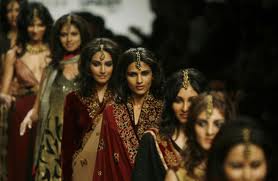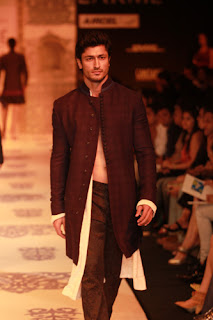Wednesday, March 23, 2011
Schizophrenic Indian Fashion
As an Indian-American, The Fashionomist has always taken a keen interest in the evolution of the Indian fashion business, which has lagged behind that of the West but is quickly becoming one of the most rapidly growing fashion centers of the world. So when my friend Akshay sent me a link about India's fashion industry, I took note.
BBC gave a special report yesterday (http://www.bbc.co.uk/news/business-12802494) about the state of Indian fashion. On the heels of India's premier fashion extravaganza, Lakme Fashion Week (held in Mumbai last week), industry watchers are all wondering the same thing: Is India on the fashion map? If one pranced over to major news outlets that feature fashion, such as the New York Times, Wall Street Journal, and the like, the reader would have absolutely no idea that one of the world's emerging economies was putting on a week-long fashion show. Even Vogue India does not highlight it's country's hottest fashion week, setting up only a video link of highlights and a slideshow of photographs from shows. No discussion, no informative feedback, no analysis - what clearly separates this from Western productions of fashion week.
Indian fashion is taking on more importance, as the income effect is in place - with a rising middle class and more money comes a desire to spend on the luxuries of life. The Fashionomist would add another economic aspect of this trend - that of the newly independent woman in India. The Indian woman, traditionally homebound, is today a free bird who gets an education, works, and spends her money as she pleases. These trends, taken together, should be a boon for the Indian fashion business.
Boon it is... for domestic retailers. While nearly a quarter of fashion buyers of Lakme Fashion Week were foreign bred, Anil Chopra, the man behind Lakme's show, notes that sales to American and European brands are nearly non-existent, primarily becomes of the ornate, more conservative Indian aesthetic that predominates, making Indian fashion more viable to Middle Eastern clients who share the same couture sense. Westerners who may appreciate the exquisite workmanship integrated in Indian fashion are not keen to purchase sequin-drenched, beadified, heavily embroidered items of clothing that are simply not marketable to a Western audience. In fact, reports suggest "95% of business conducted as a result of fashion week is domestic."
For a country of 1 billion (and growing), that might not be bad business. But, The Fashionomist can't help but feel that the Indian fashion industry is restricting itself. Granted, Indian fashion is unique in its aesthetic and is heavily influenced by its complex history - ornamentation is king in Indian textiles, and classic draping via the sari, salwar kameez, or lehnga/choli combinations that predominate Indian womenswear are favored over the dresses and pants that dominate the Western runway. But a fusion and balance could be (and, in The Fashionomist's opinion, should be) achieved to broaden the Indian market's mass appeal and promote its beautiful handiwork to a wider audience. As Imran Amed, noted author of businessoffashion.com (a treasure trove of a website, may The Fashionomist add, for the business aspect of the fashion industry), Indian designers rarely try to reach for both the domestic and international audiences - something Western fashion designers do not have in their mind at all. This distinction in marketing has made certain designers seeking to break the mold "schizophrenic," in Amed's words, as the segregation between the two markets is rather monumental. Further fueling Indian fashion's hesitancy in going beyond its borders is the supply and demand issue - producing Indian garments is costly, both in time and money. Creating a line that is viable for the Western sense in terms of mass production and clean lines that are easier to manufacture is beyond the Indian art sense, thereby further reducing both supply and demand. Nevertheless, many observers think catering to the West is unnecessary, given the growing moneyed elite that increasingly pepper fashion shows and consume high Indian fashion.
The Fashionomist thinks that Indian fashion should take a hint from the West (who have dotted the Indian urban landscape with brands like Zara, Calvin Klein, Tommy Hilfiger, Dior... the list could go on) and globalization. While Indian fashion is unique in its aesthetic, promoting desi fashion (while retaining its inherent beauty and complexity) beyond the borders is very doable and very marketable, creating further demand for Indian fashion that would boost it to world renown. For a country known for donating the wonderful fashion staples of the Madras shirt, the jodhpur, and the Nehru jacket, India can easily become the next hot destination in international fashion circles if it melds in Western sensibilities.
See also: http://www.lakmefashionweek.co.in/
*The Fashionomist*
Subscribe to:
Post Comments (Atom)























also stores like H&M and Forever 21 are lately been infiltrated with the type of airy exotics patterns and jewelry found on the streets on Indian cities
ReplyDeleteIndian influences on fashion this season are high, actually. Paris and New York were flooded with detailed embroidery and "Eastern" patterns. Elle's issue last month devoted an entire section on Indian touches on wearable fashion. Having such touches are an excellent and easy way Indian fashion can be integrated into Western wear; The Fashionomist does not understand why Indian designers do not integrate such patterns more often in marketing their items and becoming more well-known beyond India.
ReplyDelete